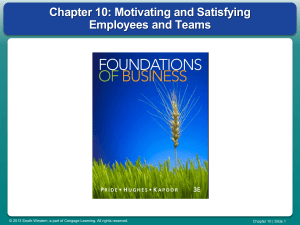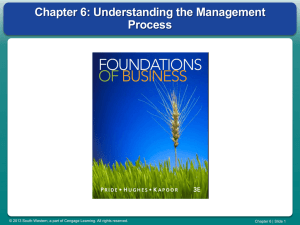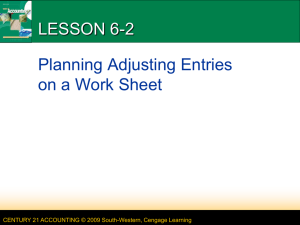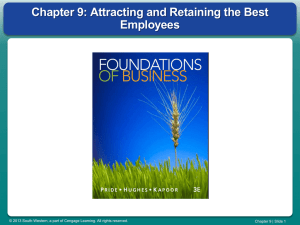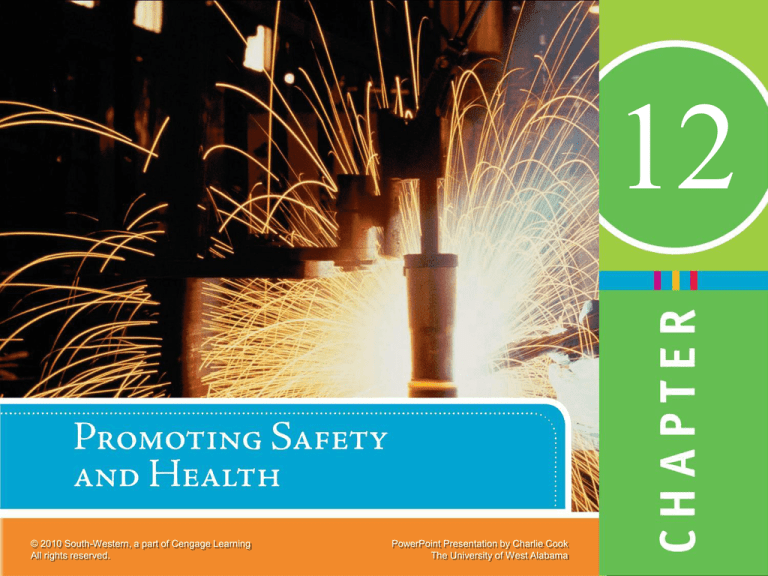
12
© 2010 South-Western, a part of Cengage Learning
All rights reserved.
PowerPoint Presentation by Charlie Cook
The University of West Alabama
Chapter Objectives
After studying this chapter, you should be able to
Summarize the general provisions of the
Occupational Safety and Health Act (OSHA).
Describe what management can do to create a
safe work environment.
Identify the measures that should be taken to
control and eliminate health hazards.
Describe the organizational services and
programs for building better health.
Explain the role of employee assistance
programs in HRM.
Indicate methods for coping with stress.
© 2010 South-Western, a part of Cengage Learning. All rights reserved.
12–2
1
Test Your Safety Smarts
Take the following quiz to evaluate your knowledge and awareness of safety and health
issues. Answers are found at the end of this chapter.
1. True or False? Employers have the right to be advised by an OSHA compliance officer of the reason for a
workplace inspection.
2. True or False? Employers have the legal right to have a company representative accompany the OSHA
compliance officer on an inspection.
3. True or False? OSHA requires that employers provide access to employees regarding the company’s
medical and exposure record.
4. What percentage of the U.S. population will be affected by back injuries?
a. 23
b. 47
c. 60
d. 80
5. True or False? In order to correct potential health and safety problems, employers have the right to know
the name of an employee who files a complaint with OSHA.
6. True or False? Employers have the legal right to request an inspection warrant before OSHA inspectors can
enter a work site.
7. Which causes more accidents: unsafe acts or unsafe conditions?
8. List five areas regarding safety that should be covered during a new employee orientation.
9. True or False? Employers are required to provide employee training on OSHA standards.
10. True or False? Carpal tunnel syndrome is the fear of enclosed areas such as silos, tanks, and hallways.
11. True or False? Employers are required to allow OSHA inspectors on premises for unannounced
inspections.
12. True or False? Employers have twenty-four hours to report to OSHA accidents that result in a fatality.
© 2010 South-Western, a part of Cengage Learning. All rights reserved.
12–3
Safety and Health: It’s the Law
• In 2006 there were 4.1 million injuries/illnesses
among private-sector firms.
• Back problems cost employers $50 billion
yearly in workers’ compensation costs and $50
billion in indirect costs
• In any year, approximately 75 million working
days are lost because of on-the-job injuries.
• In 2006, 5,840 employees died from work
accidents.
© 2010 South-Western, a part of Cengage Learning. All rights reserved.
12–4
Occupational Safety and Health Act (OSHA)
of 1970
• General Provisions
To “assure the safety and health of America’s
workers by setting and enforcing standards;
providing training, outreach, and education;
establishing partnerships; and encouraging continual
improvements in workplace safety and health.”
• Coverage of Employees
All nongovernmental employers and employees;
state and local government employees
© 2010 South-Western, a part of Cengage Learning. All rights reserved.
12–5
OSHA Provisions
• OSHA Standards
Apply to general industry, maritime, construction,
and agriculture
Cover the workplace, machinery and equipment,
material, power sources, processing, protective
clothing, first aid, and administrative requirements
• Enforcement of the Act
The Secretary of Labor is authorized by the Act to
conduct workplace inspections, to issue citations,
and to impose penalties on employers.
Inspections are conducted by the Occupational Safety and
Health Administration of the Department of Labor.
© 2010 South-Western, a part of Cengage Learning. All rights reserved.
12–6
Enforcing OSHA Standards
• Workplace inspections
• Citations and penalties
• On-site consultations
• Voluntary protection programs
• Training and education
© 2010 South-Western, a part of Cengage Learning. All rights reserved.
12–7
OSHA’s System of Inspection Priorities
First
Level
Second
Level
Inspection of imminent danger situations
Investigation of catastrophes, fatalities, and
accidents that result in hospitalization of five or
more employees
Third
Level
Investigation of valid employee complaints of
alleged violations of standards or of unsafe or
unhealthful working conditions
Fourth
Level
Special-emphasis inspections aimed at specific
high-hazard industries, occupations, or
substances that are injurious to health
© 2010 South-Western, a part of Cengage Learning. All rights reserved.
12–8
Citations and Penalties
Other-ThanSerious
A violation that has a direct relationship to job safety
and health, but one unlikely to cause death or serious
physical harm. OSHA may propose a penalty of up to
$7,000 for each violation.
Serious
A violation where there is substantial probability that
death or serious physical harm could result and the
employer knew, or should have known, of the hazard.
OSHA may propose a mandatory penalty of up to
$7,000 for each violation.
Willful
A violation that the employer intentionally and
knowingly commits, or a violation that the employer
commits with plain indifference to the law. OSHA may
propose penalties of up to $70,000 for each violation.
© 2010 South-Western, a part of Cengage Learning. All rights reserved.
12–9
Voluntary Protection Programs (VPPs)
• Programs that encourage employers to go
beyond the minimum requirements of OSHA.
Alliances
Strategic Partnership Programs (SPPs)
Voluntary Protection Programs (VPPs)
Star, Merit, and Demonstration
Safety and Health Achievement Recognition Program
(SHARP)
© 2010 South-Western, a part of Cengage Learning. All rights reserved.
12–10
2
What Are My Responsibilities under the OSH Act?
If you are an employer the OSH Act covers, you must:
• Meet your general duty responsibility to provide a workplace free from recognized hazards;
• Keep workers informed about OSHA and safety and health matters with which they are involved;
• Comply in a responsible manner with standards, rules, and regulations issued under the OSH Act;
• Be familiar with mandatory OSHA standards;
• Make copies of standards available to employees for review upon request;
• Evaluate workplace conditions;
• Minimize or eliminate potential hazards;
• Make sure employees have and use safe, properly maintained tools and equipment (including
appropriate personal protective equipment);
• Warn employees of potential hazards;
• Establish or update operating procedures and communicate them to employees;
• Provide medical examinations when required;
• Provide training required by OSHA standards;
• Report within 8 hours any accident that results in a fatality or the hospitalization of three or more
employees;
• Keep OSHA-required records of work-related injuries and illnesses, unless otherwise specified;
• Post a copy of the OSHA 300—Log and Summary of Occupational Injuries and Illnesses for the
prior year each year during the entire month of February unless otherwise specified;
© 2010 South-Western, a part of Cengage Learning. All rights reserved.
12–11
2
What Are My Responsibilities under the OSH Act? (cont’d)
If you are an employer the OSH Act covers, you must:
• Post, at a prominent location within the workplace, the OSHA poster (OSHA 2203) informing
employees of their rights and responsibilities;
• Provide employees, former employees, and their representatives access to the OSHA 300
form at a reasonable time and in a reasonable manner;
• Provide access to employee medical records and exposure records;
• Cooperate with OSHA compliance officers;
• Not discriminate against employees who properly exercise their rights under the OSH Act;
• Post OSHA citations and abatement verification notices at or near the worksite involved; and
• Abate cited violations within the prescribed period.
•
•
•
•
•
•
•
•
If you are an employee the OSH Act covers, you should:
Read the OSHA poster at the job site;
Comply with all applicable OSHA standards;
Follow all employer safety and health rules and regulations, and wear or use prescribed
protective equipment while engaged in work;
Report hazardous conditions to the supervisor;
Report any job-related injury or illness to the employer, and seek treatment promptly;
Cooperate with the OSHA compliance officer conducting an inspection; and
Exercise your rights under the • OSH Act in a responsible manner.
© 2010 South-Western, a part of Cengage Learning. All rights reserved.
12–12
Computing the Incidence Rate
• Incidence Rate
The number of injuries and illnesses per 100 full-
time employees during a given year where 200,000
equals the base for 100 full-time workers who work
forty hours a week, fifty weeks a year.
Incidence rate =
Number of injuries and illnesses × 200,000
Total hours worked by all employees during the period covered
© 2010 South-Western, a part of Cengage Learning. All rights reserved.
12–13
Hazardous Materials Regulation
• Right-to-Know Laws
Laws that require employers to advise employees
about the hazardous chemicals they handle.
• Hazard Communication Standard (HCS)
OSHA-published hazardous chemical regulations
known as the HCS prescribes a system for
communicating data on health risks of handling
certain materials.
• Material Safety Data Sheets (MSDSs)
Documents that contain vital information about
hazardous substances.
© 2010 South-Western, a part of Cengage Learning. All rights reserved.
12–14
Promoting Safe Work Environment
Safety Motivation
and Knowledge
Safety Awareness
Programs
Elements in Creating a Safe
Work Environment
Enforcement of
Safety Rules
© 2010 South-Western, a part of Cengage Learning. All rights reserved.
Accident
Investigations
and Records
12–15
Creating a Culture of Safety
• Promoting Safety Awareness
The Key Role of the Supervisor
Communicating the need to work safely.
Proactive Safety Training Program
First aid, defensive driving, accident
prevention techniques, hazardous
materials, and emergency procedures.
Information Technology and Safety
Awareness and Training
Enhanced delivery modes
Customization of training needs
Regulatory instruction
– OSHA’s Web-based eTools
© 2010 South-Western, a part of Cengage Learning. All rights reserved.
12–16
Creating a Culture of Safety (cont’d)
• Typical Safety Rules
Using proper safety devices
Using proper work procedures
Following good housekeeping practices
Complying with accident- and injury-reporting
procedures
Wearing required safety clothing and equipment
Avoiding carelessness and horseplay
© 2010 South-Western, a part of Cengage Learning. All rights reserved.
12–17
Enforcing Safety Rules
• Actively encourage employee participation in
the safety program by:
Jointly setting safety standards with management
Participation in safety training
Involvement in designing and implementing special
safety training programs
Involvement in establishing safety incentives and
rewards
Inclusion in accident investigations.
© 2010 South-Western, a part of Cengage Learning. All rights reserved.
12–18
Investigating and Recording Accidents
• Recordable Case
Any occupational death, illness, or injury to be
recorded in the log (OSHA Form 300).
Recordable accidents include: death, days away
from work, restricted work or transfer to another
job, or medical treatment beyond first aid.
Other problems include loss of consciousness or
diagnosis of a significant injury or illness by a
healthcare professional.
© 2010 South-Western, a part of Cengage Learning. All rights reserved.
12–19
FIGURE
12.1
Guide to Recording Cases under the Occupational Safety
and Health Act
© 2010 South-Western, a part of Cengage Learning. All rights reserved.
12–20
3
Job Safety
and Health
Protection
Poster
© 2010 South-Western, a part of Cengage Learning. All rights reserved.
12–21
Health Hazards and Issues
Chemical
Hazards
Ergonomics
Computer
Workstations
Smoking and
Tobacco Smoke
AIDS
Cumulative Trauma
Disorders
© 2010 South-Western, a part of Cengage Learning. All rights reserved.
12–22
4
Holsum Bakery’s Workplace Smoking Policy
Purpose
The purpose of this policy is to address some of the problems and concerns voiced by smokers and
nonsmokers. This policy does not attempt to ban smoking but restricts it to areas which are
frequently shared by smokers and nonsmokers. Also, this policy attempts to comply with recently
enacted laws in Arizona.
Recent studies have concluded that secondary smoke can have serious health consequences.
Therefore, the goal will be, to the greatest degree practicable, to obtain freedom from discomfort and
irritation for those persons sensitive to tobacco smoke, while preserving a reasonable degree of
freedom for those who choose to smoke.
Policy
It is the policy of Holsum Bakery to provide the space necessary for all of our associates to perform
their functions in clean air spaces, as well as relax in our several break rooms in smoke-free
environments, while at the same time providing separate space for those who choose to smoke.
Procedure
The designated smoking areas are the upstairs patio and the back break room. All other areas are
nonsmoking.
In outlying areas such as Thrift Stores and Depots, designated areas for smoking and nonsmoking
will be provided.
Smokers may wish to learn about our special incentive to stop smoking. Associate Services can
provide the information. In order to qualify for this offer, a person must have been employed by
Holsum on a full-time basis and must be here for a minimum of six (6) months before he/she can
apply.
© 2010 South-Western, a part of Cengage Learning. All rights reserved.
12–23
Creating a Healthy Work Environment
• Recognizing and Controlling Health Hazards
Related to Hazardous Materials and Processes
Use substitutes for hazardous materials.
Alter hazardous processes and engineering controls.
Enclose or isolate hazardous processes.
Issue clothing to protect against hazards.
Improve ventilation.
© 2010 South-Western, a part of Cengage Learning. All rights reserved.
12–24
Creating a Healthy Work Environment (cont’d)
• Problems with Video Display Terminals (VDT)
Visual difficulties, muscular aches and pains, and
job stress
Solutions:
Place the screen four to nine inches below eye level.
Keep the monitor directly in front of you.
Sit in an adjustable-height chair and use a copyholder that
attaches to both the desk and the monitor.
Use shades or blinds to reduce the computer-screen glare
created by window lighting.
Elbows close to body and supported.
Wrist and hands in-line with forearms.
© 2010 South-Western, a part of Cengage Learning. All rights reserved.
12–25
Creating a Healthy Work Environment (cont’d)
• Cumulative Trauma Disorders (Repetitive Motion
Injuries)
Injuries involving tendons of the fingers, hands, and
arms that become inflamed from repeated stresses
and strains resulting from jobs requiring repetitive
motion of the fingers, hands, or arms.
Injuries lower employee productivity, increase
employer health costs, and incur workers’
compensation payments.
© 2010 South-Western, a part of Cengage Learning. All rights reserved.
12–26
FIGURE
12.2
Key Elements for a Successful Ergonomics Program
Companies with award-winning ergonomics programs
list the following as common elements of success:
• Provide notice and training for employees. Implement a well-publicized ergonomics policy
or present ergonomic information in safety policies or training programs. Train employees,
supervisors, and managers in basic workplace ergonomics.
• Conduct preinjury hazard assessment. Survey the workplace and work processes for
potential hazards and adopt measures to lessen the exposure to ergonomic risk factors. Answer the
question: “Are certain work areas more prone to ergonomic hazards than others?”
• Involve employees. Include employees in risk assessment, recognition of MSD symptoms,
design of work-specific equipment or tools, and the setting of work performance rules and
guidelines.
• Plan and execute. Integrate ergonomic responsibilities into the performance plans for all
personnel. Demand accountability for program success.
• File injury reports. Encourage early reporting of MSD symptoms or injuries. Refer employees to
the company’s medical facilities or to the employee’s personal physician for treatment.
• Evaluate and assess the ergonomics program. Periodically review the effectiveness of
the ergonomics program. If the program appears to be ineffective, determine the underlying causes
for failure and propose corrective changes.
© 2010 South-Western, a part of Cengage Learning. All rights reserved.
12–27
Workplace Violence
• Reducing Violence in the Workplace
Management commitment to and employee
involvement in preventing acts of violence
Analyzing the workplace to uncover areas of
potential violence
Preventing and controlling violence by designing
safe workplaces and work practices
Providing violence prevention training throughout
the organization
Evaluating violence program effectiveness
© 2010 South-Western, a part of Cengage Learning. All rights reserved.
12–28
FIGURE
12.3
Violence Indicators: Know the Warning Signs
Most people leave a trail of indicators before they become violent. Similarly, disgruntled
former employees who commit acts of violence leave warning signs of their intent before
and after termination. The following behaviors should be taken seriously when assessing
situations of potential violence:
•
•
•
•
•
•
•
•
•
•
•
•
•
Direct or veiled threatening statements
Recent performance declines, including concentration problems and excessive excuses
Prominent mood or behavior changes; despondence
Preoccupation with guns, knives, or other weapons
Deliberate destruction of workplace equipment; sabotage
Fascination with stories of violence
Reckless or antisocial behavior; evidence of prior assaultive behavior
Aggressive behavior or intimidating statements
Written messages of violent intent; exaggerated perceptions of injustice
Serious stress in personal life
Obsessive desire to harm a specific group or person
Violence against a family member
Substance abuse
© 2010 South-Western, a part of Cengage Learning. All rights reserved.
12–29
Terrorism
• To deter terrorist attacks:
Heighten ID checks and baggage screening
Increase video monitoring with threat-recognition
software to back up human surveillance
Install blast-resistant glass to reduce casualties
Have offsite emergency offices
Tighten garage security with stepped-up inspections
Stagger deliveries to reduce truck traffic
Develop emergency evacuation procedures,
including escape routes, emergency equipment, and
gathering locations
© 2010 South-Western, a part of Cengage Learning. All rights reserved.
12–30
Crisis Management Teams
• Teams, composed of both hourly and
managerial employees, conduct:
Initial risk assessment surveys
Develop action plans to respond to violent
situations
Perform crisis intervention during violent, or
potentially violent, encounters
© 2010 South-Western, a part of Cengage Learning. All rights reserved.
12–31
FIGURE
12.4
Calming an Angry Employee
If you try to defuse a tense situation, remember that anger results from a person’s feeling of
being wronged, misunderstood, or unheard. Keep the following tips in mind to guide you.
• Strive to save the employee’s dignity during an angry confrontation. Do not attack a person’s rash
statements or continue a muddled line of thinking.
• Hold all conversations in private. Do not allow the employee to create an embarrassing public situation
for himself or herself, yourself, or other employees.
• Always remain calm. Anger or aggressiveness on your part will trigger a similar response in the
employee.
• Listen to the employee with an open mind and nonjudgmental behavior. Give the employee the benefit
of hearing him or her out.
• Recognize the employee’s legitimate concerns or feelings. Agree that the employee has a valid point
and that you will work to correct the problem.
• If the employee is very emotional or if the engagement seems out of control, schedule a delayed
meeting so people can calm down.
• Keep the discussion as objective as possible. Focus on the problem at hand, not the personalities of
individuals. A cornerstone of conflict resolution is to “attack the problem, not the personality.”
• If the employee appears overly aggressive, withdraw immediately and seek professional help before
any further discussion with the employee.
• If your efforts fail to calm the employee, report the incident to your manager, security, or human
resource personnel.
© 2010 South-Western, a part of Cengage Learning. All rights reserved.
12–32
Building Better Health
Alternative
Approaches
Health Services
© 2010 South-Western, a part of Cengage Learning. All rights reserved.
Wellness Programs
Focus on Nutrition
12–33
Employee Assistance Programs
Alcoholism
Depression
Abuse of Illegal
Drugs
Personal
Crises
Abuse of
Legal Drugs
© 2010 South-Western, a part of Cengage Learning. All rights reserved.
12–34
Abuse of Illegal Drugs
• The Drug-Free Workplace Act
of 1988
Requires federal contractors
and recipients of federal grants
to ensure a drug-free work
environment.
Department of Defense (DOD) and
Department of Transportation (DOT)
specify that employers entering into
contracts with them certify their
intention to maintain a drug-free
workplace.
Required drug testing for specific
positions
© 2010 South-Western, a part of Cengage Learning. All rights reserved.
12–35
5
Selected Items from Salt River Project’s Substance Abuse Policy
Purpose
Salt River Project (SRP) has established substance abuse guidelines to:
• Provide a safe workplace for all employees.
• Ensure the consistent handling of employees and job applicants involved with alcohol and drugs.
• Promote a work environment entirely free from the effects of alcohol, the abuse of legal drugs,
and the use, possession, or distribution of illegal drugs.
• Promote efficient operations.
• Promote high standards of employee health.
• Ensure employee performance.
Policy
1. SRP recognizes that employee off-the-job involvement with alcohol or drugs can adversely
affect the workplace and SRP’s ability to accomplish the goals stated above. Consequently,
SRP requires that employees report for work and be on the job completely free from alcohol
and unauthorized or illegal drugs in or upon their person.
2. Employees with a suspected or documented drug or alcohol problem shall be advised of and
may be required to seek help through the Employee Assistance Program (EAP).
3. EAP participation does not prevent disciplinary action for violation of these guidelines and
shall be considered as separate from any disciplinary action the supervisor may take prior to,
during or after such participation.
© 2010 South-Western, a part of Cengage Learning. All rights reserved.
12–36
5
Selected Items from Salt River Project’s Substance Abuse Policy (cont’d)
6. A supervisor who believes an employee is at work with alcohol or drugs in his/her
system may require the employee to go to an SRP-designated medical professional
for a medical evaluation. In the absence of an HS nurse, another supervisor, if
possible, should witness and confirm any observed deficiencies in the employee’s
performance and behavior. With the documentation of the supervisor, a drug test
can be ordered from the appropriate SRP-designated collection facility.
Transportation will be provided for the employee for such an evaluation.
New Hires
All pre-placement physical evaluations will include a lab test for substance abuse. A
job applicant who tests positive, as determined in accordance with standards
established at the sole discretion of SRP, will not be hired. If the job applicant
refuses such testing or is unable to produce a specimen within two (2) hours,
he/she will not be hired. A job applicant who has a positive test result will not be
eligible for employment for one (1) year from the date of the test. A job applicant
with a prior history of substance abuse will not be rejected solely on that basis. If an
SRP-designated medical professional believes that the applicant has been fully
rehabilitated, then the applicant will be given full consideration for employment.
© 2010 South-Western, a part of Cengage Learning. All rights reserved.
12–37
What Is Stress?
• Stress
Any adjustive demand caused by physical, mental,
or emotional factors that requires coping behavior.
• Eustress
Positive stress that accompanies achievement and
exhilaration.
• Distress
Harmful stress characterized by a loss of feelings of
security and adequacy.
© 2010 South-Western, a part of Cengage Learning. All rights reserved.
12–38
Job-Related Stress
• Sources of Job-Related Stress
High demand
High effort
Low control
Low reward
• Burnout
Most severe stage of distress, manifesting itself in
depression, frustration, and loss of productivity.
© 2010 South-Western, a part of Cengage Learning. All rights reserved.
12–39
FIGURE
12.5
Tips for Reducing Job-Related Stress
• Build rewarding relationships with coworkers.
• Talk openly with managers or employees about job or personal concerns.
• Prepare for the future by keeping abreast of likely changes in job demands.
• Do not greatly exceed your skills and abilities.
• Set realistic deadlines; negotiate reasonable deadlines with managers.
• Act now on problems or concerns of importance.
• Designate dedicated work periods during which time interruptions are avoided.
• When feeling stressed, find time for detachment or relaxation.
• Do not let trivial items take on importance; handle them quickly or assign them
to others.
• Take short breaks from your work area as a change of pace.
© 2010 South-Western, a part of Cengage Learning. All rights reserved.
12–40
burnout
cumulative trauma disorders
depression
distress
eustress
Material Safety Data Sheets (MSDSs)
recordable case
right-to-know laws
stress
© 2010 South-Western, a part of Cengage Learning. All rights reserved.
12–41

